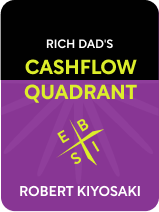

This article is an excerpt from the Shortform book guide to "Rich Dad's Cashflow Quadrant" by Robert T. Kiyosaki. Shortform has the world's best summaries and analyses of books you should be reading.
Like this article? Sign up for a free trial here .
What is cashflow? What are the different types of cashflow channels?
Cashflow is the total amount of money you earn and spend, and is the total of your income, expenses, liabilities, and assets. According to Robert Kiyosaki, cashflow is the central difference between generating income in the E (employee) and S (small business owner) quadrants and the B (big business owner) and I (investing) quadrants.
Here is how cashflow looks like in the E and S quadrants vs. the B and I quadrants.
Understanding Cashflow
Cashflow is an essential concept to understand both in terms of succeeding in the B and I categories, and it’s the central difference between the B and I categories and the E and S categories.
Income and expenses are simple as they sound. Income is the money you earn. Expenses are what you need to buy to survive that isn’t debt. Kiyosaki wants you to think of assets and liabilities as being equally simple.
- Assets give you money.
- Kiyosaki’s examples of assets: Capital gains, rental income, dividends, residual income from businesses.
- Remember, when you derive profit from an asset, it’s passive income.
- Liabilities cause you to lose money.
- Liabilities include debt, mortgages, and loans. Unlike expenses, liabilities are obligations that you must repay.
(Shortform note: There are wider definitions of “asset” and “liability” than the ones Kiyosaki gives here. You can think of an asset as being anything of financial value that you own. A liability is anything you owe. Both individuals and businesses can have assets and liabilities. Jewelry or furniture can be considered a personal asset because you can sell them in exchange for money. A business liability might include heavy machinery that must be paid off.)
According to Robert Kiyosaki, cashflow is the key difference between the E and S and the B and I quadrants.
In the E and S categories, cashflow looks like this:
- Salary/Small Business Profit – Expenses = Income
For an example in the E category, a teacher’s salary minus her living expenses equals her income. In the S category, a writer’s freelancing income minus her living expenses equals her income.
If you have liabilities in the E and S categories, your cashflow looks like this:
- Salary and/or Business Profit – Expenses and Liabilities = Income
With liabilities, a teacher or freelancer’s salary minus her living expenses minus her student loans and mortgage debt equals her income.
In the B and I categories, cashflow looks like this:
1. Capital → Assets
First, when you invest, you make an informed bet that your investment will be profitable. A profitable investment is an asset and will supply you with passive income.
2. Passive Income from Assets – Expenses & Liabilities = Income
Once you have passive income, that, minus your expenses and your liabilities if you have them, is your income. This is a fundamentally different way of making money.
Not All Assets Are Created Equal
The central difference between the E and S categories and the B and I categories is that B’s and I’s have assets, and E’s and S’s don’t. Some types of assets, though, are easier to convert to wealth than others.
You may own a company worth a million dollars, but if you’re not willing to sell it at a given moment, it’s impossible for you to access that million, making it an illiquid asset. Other examples of illiquid assets, which you can’t convert to money by selling for a set period of time, are annuities, venture capital, hedge funds, and private real estate investment trusts, or REITs. Experts say that if you invest in an illiquid asset, you should expect great returns in exchange for how inaccessible your money will be.
Liquid assets, on the other hand, are accessible at any time and include stocks, bonds, savings accounts, and mutual and index funds.

———End of Preview———
Like what you just read? Read the rest of the world's best book summary and analysis of Robert T. Kiyosaki's "Rich Dad's Cashflow Quadrant" at Shortform .
Here's what you'll find in our full Rich Dad's Cashflow Quadrant summary :
- Why the traditional path of college to career doesn't work
- Which types of income will lead you to financial freedom
- An in-depth look at Robert Kiyosaki's four cashflow quadrants






